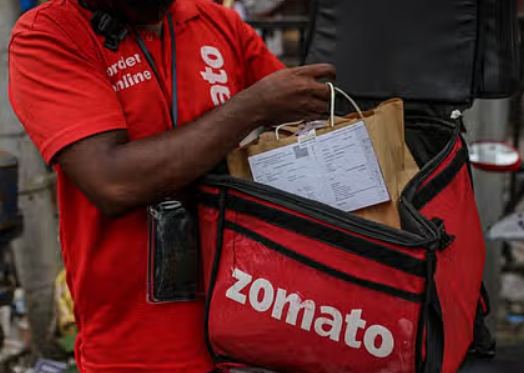
In a surprising turn of events, the Indian stock market seems to be entering a phase reminiscent of Kalyug, where traditional valuation logic is being turned upside down. Earlier, stock prices moved in tandem with a company’s profit growth. However, a bizarre new trend has emerged—profits are falling, yet stock prices are rising sharply. A recent example of this was Ola, where revenue dropped nearly 50% year-on-year, but the stock surged 18%. Now, another company has joined this puzzling rally—Zomato.
On July 21, Zomato released its Q1 FY26 results. According to the headlines, the company posted a net profit of ₹25 crore compared to ₹253 crore in the same quarter last year—a massive 90% decline. Yet, instead of falling, Zomato’s stock price soared by over 16% in just two days and crossed ₹300, pushing the company’s market capitalization to ₹2.92 lakh crore. Even more astonishing is its PE (Price to Earnings) ratio, which has now crossed 900—placing Zomato among the most expensive stocks in India.
But is Zomato truly profitable? The answer is no. The ₹25 crore "profit" being touted in the media is misleading. On digging into the company’s consolidated cash flow and shareholder letters, it becomes clear that this amount is not operational profit. Zomato earned ₹235 crore this quarter from interest income—returns from fixed deposits (FDs) made using reserves raised through IPOs and other funding. If this treasury income is removed, the company actually posted a loss of ₹210 crore.
So why are investors flocking to Zomato despite this? One reason is the impressive growth in its quick commerce business—Blinkit. Blinkit’s Gross Order Value (GOV) grew 127% year-on-year and crossed ₹9,000 crore, overtaking Zomato’s core food delivery segment. In this quarter alone, Blinkit opened 243 new dark stores, bringing the total count to 1,544. However, even with this growth, Blinkit reported a loss of ₹42 crore.
Zomato’s traditional food delivery business, which brought the company to IPO and profitability, is showing signs of saturation. Revenue in this segment has been nearly flat year-on-year—around ₹2,200 crore. Yet, this is the only segment currently generating profit: ₹465 crore this quarter compared to ₹321 crore a year ago.
Other business verticals, however, are loss-making:
Blinkit: ₹42 crore loss
Hyperpure (B2B supply to restaurants): ₹5 crore loss
Zomato Live/Ticketing/Going Out: ₹48 crore loss
Other segments: ₹45 crore loss
This reveals a deeper concern—while new businesses are growing fast in revenue terms, they continue to bleed money. Meanwhile, the only profitable segment is stagnating.
There’s another red flag. Zomato has reached a point where once a business becomes profitable, growth tends to stall. The food delivery arm saw explosive growth when it was loss-making, but now as it's profitable, growth has nearly stopped. There’s a risk that the same will happen with Blinkit and Hyperpure: rapid revenue expansion followed by stagnation once profitability is reached.
Adding to the complexity, Zomato’s internal ecosystem is starting to cannibalize itself. Blinkit has shifted from a marketplace model to an inventory-led model. Instead of third-party sellers listing products, Blinkit now directly procures and sells from its own inventory. This poses a risk to Hyperpure, which used to supply goods to many of these sellers. As Blinkit phases out third-party vendors, demand from Hyperpure could shrink, hitting its revenues.
In FY25, Zomato reported total revenue of ₹23,000 crore. Surprisingly, the second-largest revenue contributor after food delivery is now Hyperpure. But with Blinkit’s strategy shift, even this segment is under threat.

Valuation is another major concern. With ₹23,000 crore in revenue and only ₹299 crore in net profit (primarily due to FD interest), the company's valuation of ₹3 lakh crore seems wildly overstretched. Assuming a future net profit margin of 10% (a generous estimate in this low-margin industry), the company would still only generate around ₹2,300 crore in profit. That would imply a PE ratio of 130—still extremely high. And if Zomato is expected to grow its revenue and profits by 40-50% annually to justify this valuation, it is a tall order in such a competitive and operationally heavy industry.
To justify a ₹600 share price, Zomato would need a market cap of ₹6 lakh crore. That would push its PE ratio past 1000—nearly impossible to rationalize with current fundamentals.
There are also leadership-related concerns. CEO Deepinder Goyal has reportedly been reducing his stake in the company over time. He recently purchased a ₹52 crore luxury apartment in DLF Camellias, Gurgaon—more than twice Zomato’s quarterly net profit. He’s also reportedly launching a new low-cost airline venture focused on regional connectivity, raising questions about his focus on Zomato’s core business.
Additionally, Zomato's shareholder letter revealed an unusual leadership decision—the CEO of the food delivery business will change every two years. While the company claims this will bring fresh energy, such frequent changes can hinder long-term strategic execution.
In conclusion, Zomato's rising stock price in the face of deteriorating profits, operational losses, and shifting business models raises serious questions. Much of the perceived profit is coming from interest income—not core operations. The rapid revenue growth in new business segments is currently being driven by burning cash. And with saturation setting in for profitable units and rising competition (like Rapido’s planned entry into food delivery with a zero-commission model), Zomato faces a long road to sustainable, consistent profitability.
Investors need to look beyond headline numbers and flashy growth figures. Real wealth creation in the stock market comes from companies with solid, operational profit—not just from FD interest or inflated valuations. Zomato’s current valuation appears more speculative than grounded in reality. As things stand, it’s more of a high-risk, sentiment-driven bet than a long-term value investment.
Disclaimer:
The content of this article is for informational and educational purposes only and should not be construed as investment advice or a recommendation to buy, sell, or hold any securities. The analysis is based on publicly available data and personal interpretations, which may be subject to change. Always consult with a certified financial advisor before making any investment decisions.




